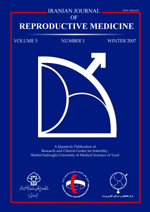
|
International Journal of Reproductive BioMedicine
Research and Clinical Center for Infertility, Shahid Sadoughi University of Medical Sciences of Yazd
ISSN: 1680-6433
EISSN: 1680-6433
Vol. 11, No. 12, 2013, pp. 977-982
|
 Bioline Code: rm13123
Bioline Code: rm13123
Full paper language: English
Document type: Research Article
Document available free of charge
|
|
|
International Journal of Reproductive BioMedicine, Vol. 11, No. 12, 2013, pp. 977-982
| en |
Uterine cavity assessment in infertile women: Sensitivity and specificity of three-dimensional Hysterosonography versus Hysteroscopy
Ahmadi, Firoozeh; Rashidy, Zohreh; Haghighi, Hadieh; Akhoond, Mohamadreza; Niknejadi, Maryam; Hemat, Mandana & ShamsiPour, Mansour
Abstract
Background: Assessment of uterine abnormalities is a core part in infertility evaluation.
Objective: The aim of this study was to evaluate the sensitivity and specificity of three-dimensional hysterosonography (3-DHS) in the diagnosis of uterine abnormalities in infertile women.
Materials and Methods: The infertile women who visited Royan Institute and referred to 3-DHS consecutively, prior to in vitro fertilization, from 2010-2011 included in this cross-sectional study. For patients who underwent hysteroscopy in addition to 3-DHS (214/977), the verification bias adjusted sensitivity and specificity of 3-DHS which were calculated by global sensitivity analysis method. Hysteroscopy was used as the gold standard for diagnosis of uterine abnormalities. Histological diagnosis of resected endometrial tissues by hysteroscopy was assessed and the adjusted sensitivity and specificity of 3-DHS and hysteroscopy in detection of polyp or hyperplasia were determined. Histopathologic results were considered as the gold standard for diagnosis of polyp or hyperplasia.
Results: The overall sensitivity and specificity for 3-DHS in diagnosis of uterine anomalies considering hysteroscopy as the gold standard were 68.4% and 96.3% respectively. Sensitivity and specificity of hysteroscopy in diagnose of polyp or hyperplasia was calculated at 91.3% and 81.4% respectively. Sensitivity and specificity of 3-DHS in diagnosis polyps or hyperplasia was calculated at 91.4% and 80.2 % respectively.
Conclusion: The results of present study proved that, compared to hysteroscopy; 3-DHS has a reliable specificity for diagnosis of uterine abnormalities. Sensitivity and specificity of 3-DHS and hysteroscopy in detecting polyp or hyperplasia regarding histopathology as the gold standard was the same.
Keywords
Three-dimensional hysterosonography; Hysteroscopy; Uterine cavity
|
| |
© Iranian Journal of Reproductive Medicine
Alternative site location: http://www.ijrm.ir
|
|
